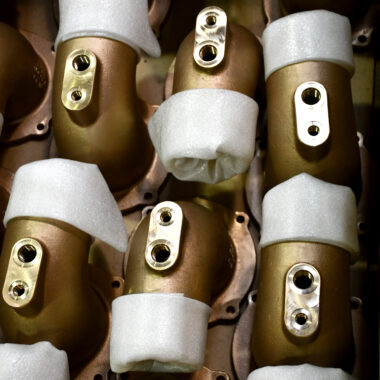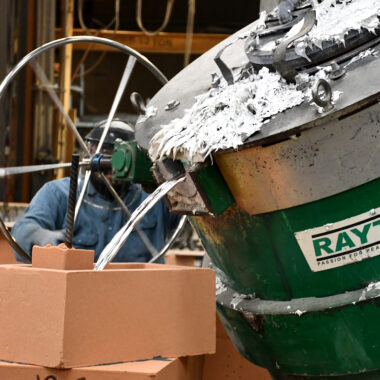Understanding About Aluminum Casting: Strategies Debunked
Understanding About Aluminum Casting: Strategies Debunked
Blog Article
Check Out the Globe of Light Weight Aluminum Spreading: Expert Tricks and Approaches
In the world of production, aluminum spreading stands as a critical procedure, crucial for the production of a vast selection of products. Behind the relatively uncomplicated method lie a wide range of elaborate facets, frequently unbeknownst to many. As we navigate via the globe of aluminum casting, there exists a world of expert keys and techniques that can elevate the high quality of the last products and simplify the manufacturing procedure. By uncovering these hidden treasures and exploring the subtleties of this craft, an entire brand-new measurement of possibilities emerges, promising to transform the means we involve and regard with light weight aluminum casting.

The Essentials of Aluminum Spreading
Aluminum casting, a fundamental process in manufacturing, involves the pouring of liquified aluminum right into a mold and mildew to attain wanted shapes and structures. This flexible method is commonly made use of throughout different sectors as a result of aluminum's outstanding properties such as high strength-to-weight proportion, rust resistance, and thermal conductivity.
The procedure starts with the melting of light weight aluminum in a heater at temperature levels exceeding 1220 ° F(660 ° C ) As soon as the aluminum reaches its fluid state, it is poured into a pre-designed mold cavity. The mold, normally made from materials like steel or sand, establishes the last form of the cast light weight aluminum component.
After pouring, the light weight aluminum is left to strengthen and cool within the mold and mildew - about aluminum casting. This cooling duration is essential as it determines the stability and top quality of the end product. Once solidified, the mold and mildew is removed, exposing the newly developed aluminum casting
Expert Tips for Effective Casting
To accomplish optimum results in light weight aluminum casting, precise focus to detail throughout the mold and mildew style phase is essential for making certain successful outcomes. One insider idea for effective spreading is to meticulously think about eviction system. The style of the gating system plays a critical role in regulating the circulation of liquified light weight aluminum into the mold tooth cavity, making certain correct dental filling and decreasing defects like air entrapment. Additionally, maintaining the proper metal temperature is crucial for achieving high-grade spreadings. Tracking and regulating the metal temperature level throughout the spreading process can help protect against issues such as early solidification or porosity in the end product.
Furthermore, another crucial idea is to appropriately prepare the mold surface area. A well-prepared mold surface area can add to better metal flow, lowered turbulence, and enhanced surface area finish on the cast component. This preparation might involve utilizing therapies or coverings to improve mold release and avoid metal/mold interactions that could bring about issues. By paying attention to these insider ideas, suppliers can enhance the high quality and performance of their aluminum casting processes.
Advanced Methods in Aluminum Casting
Utilizing ingenious techniques and advanced methods, the world of aluminum casting has actually seen a significant advancement towards progressed techniques that press the boundaries of traditional practices. One such technique is vacuum casting, which entails developing a vacuum cleaner environment to remove air from the mold dental caries, causing better and more complex castings with minimized porosity. In addition, financial investment casting, also referred to as lost-wax casting, is a polished technique that enables for thin wall surfaces and complicated shapes, leading to comprehensive and exact light weight aluminum components.

Additionally, advanced simulation software program plays a vital function in maximizing casting styles and anticipating potential flaws, enabling changes to be made before the real casting process starts. By welcoming these advanced strategies, suppliers can boost their aluminum casting abilities to new heights, meeting the demands of contemporary markets with precision and development.
Recognizing Different Casting Techniques
Various casting techniques supply special benefits and are selected based on variables such as the intricacy of the style, manufacturing volume, material requirements, and cost factors to consider. One of the most typical spreading techniques is sand spreading, where a mold is produced using sand as the key material.
An additional preferred casting approach is pass away spreading, which entails injecting liquified steel into a mold and mildew dental caries under high stress. By comprehending the subtleties of different spreading approaches, producers can make enlightened choices to maximize their manufacturing procedures and attain the wanted end results.
Making The Most Of Efficiency in Casting Operations
With a strong understanding read here of the subtleties of different casting approaches, producers can simplify their operations to boost performance in steel fabrication procedures. Optimizing performance in casting operations needs an organized strategy that concentrates on enhancing every action of the spreading procedure. One vital approach is to execute lean manufacturing principles to get rid of waste and enhance general efficiency. By recognizing and eliminating bottlenecks in the assembly line, makers can boost operations and reduce preparations.
Furthermore, purchasing innovative innovation and devices can significantly boost efficiency in casting procedures. Automated systems, robotics, and computer-aided design (CAD) software program can improve procedures, minimize errors, and increase result. In addition, training employees on the most recent techniques and best practices can likewise add to making the most of performance in casting procedures.
Normal maintenance of tools and devices is vital to protect against malfunctions and reduce downtime - about aluminum casting. Executing a proactive upkeep timetable can assist identify prospective problems prior to they rise, making sure smooth operations and continuous production. Overall, click this link by focusing on efficiency and constant improvement, producers can optimize their casting procedures and remain affordable in the market

Verdict
In conclusion, the world of light weight aluminum spreading uses a wide variety of chances for those looking to develop complex and resilient metal objects. By grasping the essentials, using expert tips, and exploring sophisticated methods, people can accomplish terrific success in their spreading undertakings. Understanding the numerous casting techniques and optimizing efficiency in operations are crucial elements to attaining high-quality lead to light weight aluminum casting. With devotion and method, one can truly unlock the potential of this flexible metalworking process.
One such technique is vacuum casting, which includes creating a vacuum cleaner atmosphere to eliminate air from the mold cavity, leading to greater top quality and even more intricate castings with decreased porosity (about aluminum navigate to these guys casting). Additionally, financial investment spreading, also recognized as lost-wax spreading, is a refined technique that enables for thin walls and complicated forms, resulting in comprehensive and precise aluminum components
One of the most usual casting techniques is sand spreading, where a mold and mildew is created making use of sand as the key material.An additional preferred casting technique is die spreading, which involves injecting molten metal into a mold and mildew dental caries under high stress. Understanding the numerous casting techniques and optimizing performance in operations are key components to achieving high-quality results in aluminum casting.
Report this page